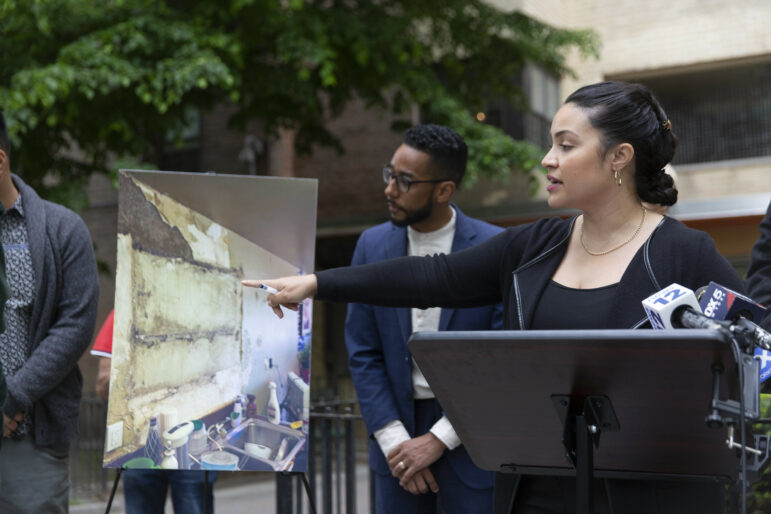The city’s ballyhooed promise to prevent landlords from abandoning their run-down apartment buildings in low-income neighborhoods has collapsed on the eve of its implementation, City Limits has learned.
On Halloween Day in 1995, Mayor Giuliani and Deborah Wright, then-commissioner of the city’s Department of Housing, Preservation and Development, unveiled a bold new housing initiative. It was, the mayor said, “designed to keep housing in responsible private hands.” It was also designed to blunt growing criticism that the administration didn’t give a hoot about housing.
In keeping with Giuliani’s order that HPD never again take ownership of buildings from landlords in tax arrears, the system was to offer little in the way of direct management of broken buildings. Rather, the city would use technology, shoe leather and negotiating expertise to intervene with owners before their buildings fell apart.
The first component of the new system, Wright announced, would be an “early warning system” to predict which buildings were most neglected. Second, the city would provide technical assistance and low-interest loans to well-intentioned landlords who had fallen on hard times. If that failed, Wright’s agency would briefly take over the properties, almost immediately handing them over to pre-screened private landlords or community-based nonprofits.
All that needed to be worked out, they said, were the technical details.
But 18 months and two HPD commissioners later, the ambitious strategy is unfunded and unfinished. The administration’s Halloween commitment has turned out to be more trick than treat.
“The trouble is that nobody at the whole agency really gives a shit about the issue of housing anymore,” said a former top aide to Lilliam Barrios-Paoli, the second commissioner to leave HPD in a year. “There is no budget for the anti-abandonment plan… With the money, this thing could be one of the most important programs in the history of New York City housing.”
According to high-ranking administration sources and outside consultants, the project is dying for lack of the $20 million that former HPD officials say is needed to get the transfer system–the key component of the plan–off the ground. Even though the program requires government-subsidized loans and grants to aid in the repair of poorly maintained buildings, the administration has been unwilling to commit new funds to those programs in the Fiscal Year 1998 preliminary budget.
An equally bad problem is HPD’s organizational instability. Besides the repeated loss of its commissioners, the agency has recently suffered the defection of its development chief, its planning and sales director and the head of its emergency repair program. Gone too are nearly 100 of the mid-level technocrats who had accumulated years of housing knowledge necessary to make the plan work.
“They’re going to just limp along,” says Joe Center, a longtime housing activist and nonprofit developer. “Then they are going to let the whole anti-abandonment thing die in the wind. No money. No commitment. Nothing. It’s just an unbelievable tragedy.”
_______
HPD sources say the future of the plan brightened briefly last year, when then-commissioner Barrios-Paoli met with the mayor to seal a deal that would have pumped millions of dollars into anti-abandonment.
What happened at that meeting isn’t entirely clear, but Barrios-Paoli reportedly asked that HPD be allowed to keep some or part of the estimated $15 to $20 million that has been saved by selling off thousands of tax-foreclosed, in rem properties.
HPD sources say the mayor seemed surprisingly amenable to Barrios-Paoli’s suggestion. “The idea was that half of the money would go to the anti-abandonment program and the other half would go into economic development initiatives,” an administration source says. “But it died because she didn’t really keep the pressure up.”
Barrios-Paoli denies ever having made a deal with Giuliani, but says: “It’s certainly an idea I would support. I’ve always said that the resources for anti-abandonment can come from money already in HPD’s budget.” And HPD’s newest commissioner, Richard Roberts, appointed last month, told City Limits he needed to study the issue before commenting on the need to fight to keep the in rem money inside the agency.
But another current Giuliani commissioner who has frequent dealings with HPD says the Barrios-Paoli cost-recovery idea is coffin-nail dead: “Any more money going into housing? I’d call that extreme wishful thinking.”
Indeed, throughout the Giuliani administration, the focus in housing has been to save money, not to spend more on the expensive building renovations that have been the heart of HPD’s traditional mission. In fact, the only mention Giuliani made of housing in his February management report was that the city continued to sell off an average of 4,000 buildings a year to private landlords, nonprofit groups and tenant-run cooperatives.
_______
A year ago, Giuliani’s finance commissioner figured out an even more ingenious scheme to generate long-denied revenue off of the city’s housing stock. By selling off old tax-lien debt to private investors–who in turn have hired collection agents to squeeze payments from owners–the city netted more than $400 million without having to threaten takeover of a single building.
But in hatching the tax lien sale, Giuliani’s minions initially made no provisions to protect the buildings’ low-income tenants who might have faced evictions or deteriorating conditions if owners, unable to pay off the liens, abandoned their buildings. (See Sell Out in the May 1996 City Limits.) In a frenzied legislative session before the lien sales, tenant advocates, council staffers and Harlem Councilwoman Virginia Fields forced the city to pluck 2,500 “distressed buildings” with 60,000 apartments out of the lien sales pool.
As importantly, the law codified the Wright anti-abandonment plan, forcing the administration to defend its record during periodic oversight hearings.
At just such a hearing on January 31, HPD Deputy Commissioner Cynthia Fisher indicated the agency would unveil a “pilot” version of the property transfer program by the end of the year. When pressed for more details, Fisher would not disclose which neighborhoods would be involved–but did indicate the program would rely heavily on for-profit owners willing to invest their own resources on buildings.
“HPD is still planning for a comprehensive citywide anti-abandonment program,” she assured the three councilmembers that stayed for the duration of the meeting. “But because of the limited amount of capital dollars available, we will make a major effort to identify owners who can [take over distressed buildings] without city money.”
“There are enormous logistical problems,” she added, in an apparent allusion to the agency’s cash and personnel woes.
Fisher said buildings that couldn’t independently find new, white-knight ownership would rely heavily on the 7a program, in which court-appointed administrators are empowered to take control of distressed buildings. By using HPD-subsidized 7a loans, the emergency repair program and heating fuel drops, administrators are able to stabilize poorly maintained buildings and resume rent collections.
But, as of now, there is almost no funding for the program. Last year, Giuliani budgeted about $1.5 million for 7a loans, and this year’s budget calls for only $500,000 more, which would pay for the rehab of about 70 apartments.
Moreover, HPD’s recent attempts to streamline the 7a process have been a failure. Two requests-for-proposals sent to community groups interested in becoming 7a administrators have been withdrawn for retooling during the last year. And the latest version of the RFP contains no reference to the use of 7a as an anti-abandonment centerpiece.
_______
Even with a new and adequately-funded 7a program, the anti-abandonment system would likely require extra money to help stabilize the 60,000 units of distressed housing that were pulled from the city’s tax lien sale because they were in imminent danger of being abandoned.
How much money would be needed? Even the most modest $10,000-per-unit repair regimen would cost the city $600 million. Yet so far, the mayor hasn’t been willing to allocate even a fraction to the loan and grant programs that would be used for anti-abandonment purposes.
Fisher, the highest-ranking HPD holdover from the Barrios-Paoli regime, refused City Limits requests to comment on these issues.
“What you’ve got here is an agency that is being systematically purged of any knowledge and talent,” says Jay Small, executive director of the Association of Neighborhood and Housing Development. “And it indicates a lack of interest in housing on the administration’s part.”
Small and other housing experts say existing financial tools HPD could use to help struggling landlords stabilize their buildings have also been deprived of serious money. The Participation Loan Program, which combines government and bank money to give landlords below-market-rate loans for building rehabs, has suffered both federal and city cuts in the ’90s. And the Article 8a program, which offers low-interest loans for less extensive work, has had its budget doubled in Fiscal Year 1998 to $6 million, but that’s still a fraction of its 1980s funding level, when HUD bankrolled the program.
Add to this the fact that the federal government has stopped issuing new Section 8 vouchers for low-income tenants–something many landlords in the city’s poorest neighborhoods rely on to keep rent rolls at a level where they can pay for basic maintenance–and the dimensions of HPD’s crisis becomes clear.
_______
Desperate to salvage the anti-abandonment effort without reasonable funding, agency policymakers have begun considering a scheme to take money from the rent rolls of better buildings to pay for repairs on the worst-maintained buildings with the poorest tenants.
“It’s their idea to cluster the buildings together, the economically viable ones with the worst ones,” says Brent Sharman a housing analyst with the Community Service Society whom HPD consulted on the plan. “But I think HPD’s assumptions about the average rent rolls [of the better buildings] are foolishly optimistic. Even in the best buildings, you’re not dealing with wealthy tenants…. I think they are increasingly realizing the folly of it.”
If the loan programs and third-party-transfer system are hurting for lack of cash, the “Early Warning System” has fallen victim to HPD’s personnel turnstile. The main architect of the system, which is supposed to collect data on a building’s viability in a central geographic information system, was former deputy commissioner Harold Shultz. He reportedly got into a fight with Barrios-Paoli and was driven from the agency.
And although Fisher promised a pilot of the system sometime later this year, she warned it would be a scaled-down version that probably wouldn’t be accessible to the public. Others offer a less charitable description: “There’s been no computerization at HPD at all,” says a Giuliani administration source.
Small believes that the administration has been actively trying to stonewall the dozens of community housing groups seeking information on the status of the system. “The early warning system is bullshit, it doesn’t exist and there’s no indication it’s ever going to exist,” Small adds.
Meanwhile, the nonprofit housing groups say they need detailed early warning information–such as housing court records, code violations, tax information and fire department inspection records–to help tenants fight negligent landlords or even work out their own deals to take over the distressed buildings.
But even the early warning system’s ills boil down to the issue of money. Ultimately, the purpose of the system has always been to identify buildings that can then be channeled into the anti-abandonment system. Without a funded anti-abandonment strategy, the Giuliani administration has no incentive to identify even more poor tenants that it can’t–or won’t–help.
“It’s all semantics,” says ANHD’s Celia Irvine, who was instrumental in drafting the City Council’s housing law barely a year ago. “If you aren’t willing to commit the money, everything else is basically useless.”








